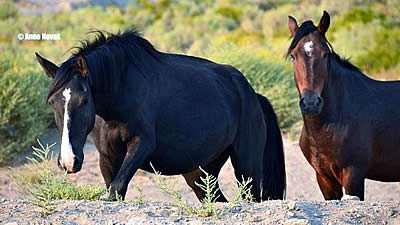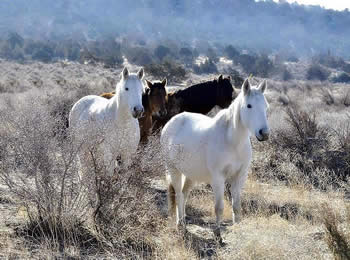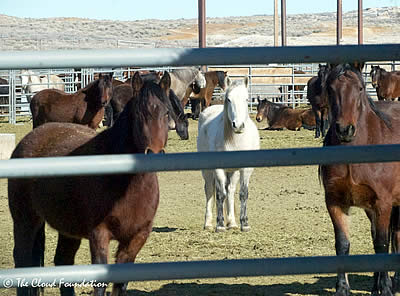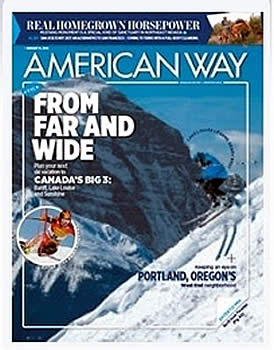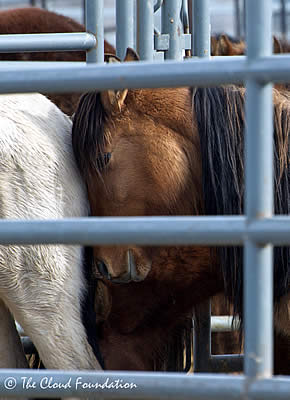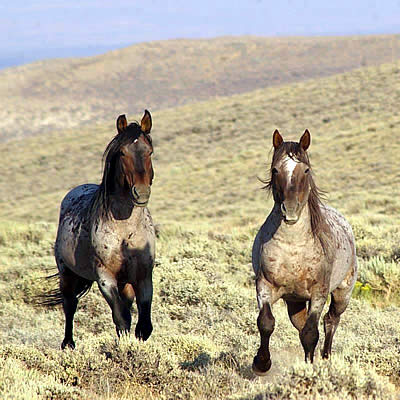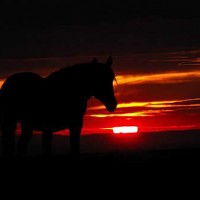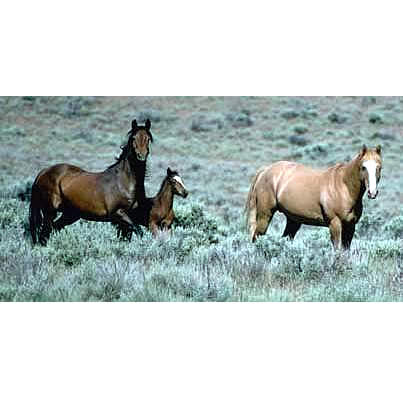Dear Friends of Wild Horses and Burros,
Here is the latest problem we are facing to stop the roundups and protect all the threatened herds of wild horses living in freedom on public land:
We encourage the public to stop panicking and read everything they are asking their senators and representatives to do on their behalf.
Are wild horses really at risk of being slaughtered if they aren’t sterilized?
Is something in that form letter you received that you don’t agree with? Do you want wild horses sterilized using EPA approved restricted use pesticides?
These pesticides are not safe for domestic horses so why are they being pushed for use on wild horses? Are you giving up the fight for their freedom to live in natural family bands?
Why is an advocacy group encouraging their supporters to write members of Congress–via click and send form letter–asking them to sign on to the pledge to sterilize wild horses (already in non-viable herds) when BLM overpopulation claim is false?
We found their pitch citing a quote from the National Academy of Sciences 2013 report in their form letter being circulated around the Internet. It reads:
“… Considering all the current options, [porcine zona pellucida (PZP) vaccines and GonaCon vaccine for females and chemical vasectomy for males] either alone or in combination, offer the most acceptable alternative to removing animals for managing population numbers…. ”
Even worse is the pledge they are requesting members of Congress sign and return the advocacy group’s office.
Senators and representatives will think the public wants “[porcine zona pellucida (PZP) vaccines and GonaCon vaccine for females and chemical vasectomy for males] either alone or in combination.” Is that what you want?
Or do you want to stop the roundups with a 10-year moratorium (suspension) on roundups for scientific research to investigate what’s the best way to manage the underpopulated herds of wild horses left in the West?
Why is this group pushing an elected official “pledge” to use “available fertility control” without scientific studies on population, migration, and holistic land management? What is going on here? Who is funding this scare-tactic-based campaign to sterilize America’s wild horses?
Why isn’t the group mentioning to members of Congress that the National Academy of Sciences report also said there is “no evidence” of overpopulation–why omit this?
Why hasn’t the group done any independent aerial or in-the-field research on population? Is it because it would not support the BLM’s faulty overpopulation claim?
See for yourself how many wild horses are left in the 800,000 acre Twin Peaks area during a recent aerial survey: VIDEO: http://vimeo.com/81195843. Read the scientific report exposing an underpopulation crisis on public land: http://protectmustangs.org/?p=6278.
The group appears to know wild horses are not overpopulated. Recently they were quoted in an Associated Press article debunking the BLM’s overpopulation claim in comparison with livestock on public land.
Why then are they attempting to lead the public into blindly supporting a plan lacking good science–a plan calling for permanent and temporary sterility actions against indigenous wild horses?
Is the group alluding to a false risk of all wild horses going to slaughter if they aren’t sterilized?
Why create all the panic so people will quickly click, sign and share the pledge with their senators and congressional representatives asking them to “take the pledge” for sterilization, etc.? Is the public reading what they are signing on to?
Why is the group pushing for “fertility control”–using sterilizants passed by the EPA as “restricted use pest control”? Wild horses are a native species. How can restricted use pesticides be used on native species? Read more here: http://www.thedesertinde.com/Articles-2012/EPA-Calls-Wild-Horses-Pests–0511.html.
Many other valid concerns about PZP were brought up in this 2010 article as well: http://www.horsetalk.co.nz/news/2010/10/220.shtml#axzz2tlL9dGaX, and in Ecologist Craig Downer speaks out against using PZP in the Pryors: http://protectmustangs.org/?p=4178.
Did you know that International Society for the Protection of Mustangs and Burros (ISPMB) wild horse herd study shows that functional social structures contribute to low herd growth compared to BLM managed herds? http://protectmustangs.org/?p=6057
Even the National Academy of Sciences reported roundups resulted in abnormal increased birthrate. Are wild horses and burros fearing extinction now?
What if you follow the money?
Are American wild horses becoming lab rats for immunocontraceptives for other species including humans? Read the reference section at the bottom this research paper: http://randc.ovinfo.com/e200501/yuanmm.pdf.
How can man (BLM and others) decide which wild horses to sterilize on the range and who to breed? That would be the end of survival of the fittest and the beginning of domestication of the wild horse and burro.
Is the group’s paradigm flawed because it focuses on the individual wild horse and neglects to view the herd as most important–as the lifeblood?
Sanctuaries might need to sterilize wild horses because they have limited space but policy for native wild horses living in the wild should not be modeled after a sanctuary model–unless it is based on reserve design.
America’s native wild horses and burros are wild animals who benefit the ecosystem and fill their niche, reduce wildfire fuel, and help reverse desertification. They are not back alley cats that should be spayed and neutered because of an overpopulation problem. (No offense to cats.)
The alleged overpopulation problem for wild horses and burros is a farce.
Now the question is: What do we do to save the wild horses from those who are pushing for risky temporary and permanent sterilization using EPA approved “restricted use pesticides” on non-viable herds?
1.) Share this petition widely and don’t forget friends and family. http://www.change.org/petitions/defund-and-stop-the-wild-horse-burro-roundups?utm_source=supporter_message&utm_medium=email&utm_campaign=petition_message_notice
2.) Sign and share everywhere the petition for a moratorium on roundups for scientific research. http://www.change.org/petitions/sally-jewell-urgent-grant-a-10-year-moratorium-on-wild-horse-roundups-for-scientific-research?utm_source=supporter_message&utm_medium=email&utm_campaign=petition_message_notice Good science will find real solutions to protect wild horses and burros on the range.
3.) Send an email to your senators and your representatives if you don’t want America’s wild horses to be sterilized. Let them know you didn’t read the fine print of the form letter you signed and sent to them, if that is the truth.
4.) Meet with your senator’s aides and your representative to request they intervene in the wipe-out of America’s wild horses and burros by defunding the roundups and granting a 10-year moratorium on roundups for scientific research on population, migration, reserve design, holistic land management, etc.
5.) Visualize miracles of wild horses living in natural family bands in freedom.
Remember don’t let anyone scare you into believing wild horses are going to be slaughtered if they aren’t sterilized. Fight the good fight for our symbols of freedom and our national living treasures–America’s wild horses and burros.
Links of interest:
Contact your senators and representatives: http://www.contactingthecongress.org/
Petition for a Moratorium on Roundups: http://www.change.org/petitions/sally-jewell-urgent-grant-a-10-year-moratorium-on-wild-horse-roundups-for-scientific-research?utm_source=supporter_message&utm_medium=email&utm_campaign=petition_message_notice
The Horse and Burro as Positively Contributing Returned Natives in North America, American Journal of Life Sciences by Craig C. Downer: http://www.sciencepublishinggroup.com/journal/paperinfo.aspx?journalid=118&doi=10.11648/j.ajls.20140201.12
American wild horses are indigenous: http://protectmustangs.org/?p=3842 and http://protectmustangs.org/?page_id=562
January 26, 2014 Washington Post (Viral) U.S. looking for ideas to help manage wild-horse overpopulation: http://www.washingtonpost.com/national/health-science/us-looking-for-ideas-to-help-manage-wild-horse-overpopulation/2014/01/26/8cae7c96-84f2-11e3-9dd4-e7278db80d86_story.html
Ecologist Craig Downer speaks out against using PZP in the Pryors: http://protectmustangs.org/?p=4178
International Society for the Protection of Mustangs and Burros (ISPMB) herds show that functional social structures contribute to low herd growth compared to BLM managed herds: http://protectmustangs.org/?p=6057
Public outraged over the EPA approving pesticides for NATIVE wild horses: http://protectmustangs.org/?p=3866
GASLAND 2, a film by Josh Fox, the plight of wild horses is featured: http://www.gaslandthemovie.com/
Wild Horses and Renegades, a film by James Anaquad Kleinert: http://theamericanwildhorse.com/
EPA calls wild horses pests, Desert Independent: http://www.thedesertinde.com/Articles-2012/EPA-Calls-Wild-Horses-Pests–0511.html
Protect Mustangs’ letter requesting EPA repair error classifying iconic American wild horses “pests”: http://protectmustangs.org/?p=1191
EPA Pesticide Information for ZonaStat-H: http://www.epa.gov/pesticides/chem_search/reg_actions/pending/fs_PC-176603_01-Jan-12.pdf
AVMA Reports: Vaccine could reduce wild horse overpopulation: http://www.avma.org/onlnews/javma/apr12/120415k.asp
Wildlife fertility vaccine approved by EPA: http://www.sccpzp.org/blog/locally-produced-wildlife-contraceptive-vaccine-approved-by-epa/
Oxford Journal on PZP for Humans and more: http://humrep.oxfordjournals.org/content/20/12/3271.long
PZP research for humans http://randc.ovinfo.com/e200501/yuanmm.pdf
Wild horse predators: http://sg.answers.yahoo.com/question/index?qid=20080302002619AADTWzh
Princeton reports: Wildlife and cows can be partners, not enemies, in search for food: http://www.princeton.edu/main/news/archive/S32/93/41K10/index.xml?section=featured
Visit our website: www.ProtectMustangs.org
Contact us if you want to help the wild horses and burros survive the politics that are trying to bring them down. We need volunteers, donors and people to help get this petition out there! Email Contact@ProtectMustangs.org.
Thank you for helping the wild horses and burros by signing and sharing the Petition to Defund and Stop the Roundups!
The star studded documentary, ‘Wild Horses and Renegades’ by James Anaquad Kleinert requests a moratorium on roundups. See the video clip here: http://www.youtube.com/watch?v=Ay1FUpzBIGs.
It’s time to pick the torch back up and continue the fight. Never give up. We the people must take back the power for the voiceless wild ones we love!
Please share this petition far and wide: http://www.change.org/petitions/defund-and-stop-the-wild-horse-burro-roundups?utm_source=supporter_message&utm_medium=email&utm_campaign=petition_message_notice
Together we can turn this around.
In gratitude,
Anne Novak
Executive Director of Protect Mustangs
www.ProtectMustangs.org
